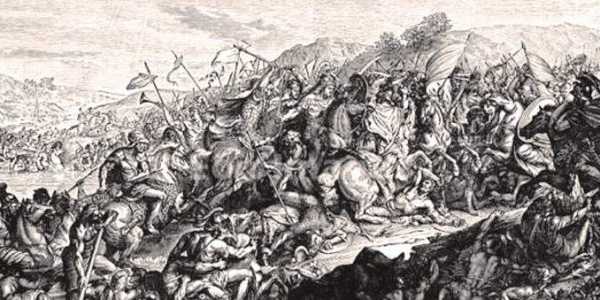
nuclear war
Introduction
The Kalinga War is considered the most horrendous and deadliest battle in Indian history. The battle happened during the great king Ashoka’s era, in the present-day Orissa. This was the last battle for Ashoka, whose devastation enlightened him to follow the path of peace. This battle served as the major reason for the blossoming of Buddhism in various countries like Sri Lanka, Burma, Thailand, etc.
Kalinga -The Lord of Oceans
Kalinga was the major port that had overseas contact with Java, Bali, Malay Peninsula, China etc. It was a sumptuous and flourishing state with magnificent art and architecture. The great poet Kalidasa mentioned the King of Kalinga as “The Lord of the Ocean”. For its favourable geographical setting, the Kalingan sailors were acclaimed as “Kalingah Sahasikah”, which means “The Brave Kalingans” in the ancient Sanskrit literature.
Ashoka
Ashoka was the third monarch in the Mauryan Dynasty. His name Ashoka means “painless and without sorrow” in Sanskrit. His grandfather Chandragupta Maurya was the founder of this vast dominance dynasty. Ashoka’s elder brother Susima had been anointed as the King of Magadha by Bindusara. But Ashoka had murdered his brother to ascend the throne of Magadha.
The Rise of the Kalinga War
After the decline of the Nanda Dynasty under his grandfather Chandragupta Maurya, Kalinga became an independent state. The predecessors of Ashoka-Chandragupta and Bindusara tried to conquer this state, but all their attempts were in vain. The geographical features and favourable trade port of Kalinga propelled Ashoka’s interest in it, so he decided to conquer it and expand his territory. The bloodiest battle took place between Raja Ananta Padmanabha of Kalinga and Ashoka, on the banks of the Daya River. The Kalingan army had 60,000 infantry, 1,000 cavalry and 700 elephants. The Greek ambassador Megasthenes mentioned that the military strength of Magadha could be one lakh, which consisted of 1700 horses, thousands of elephants, and 60 thousand soldiers. Historians describe how the soldiers of Kalinga fought till their last breaths and were near to victory. However, Ashoka and his forces were overpowerful and won the battle.
The aftermath of the war
After the war, the iridescent blue colour of the River Daya had changed to blood red. The Kalinga battleground had become the land of grief, blood and tears. Nearly a lakh lives had been lost and 1.5 lakh Kalinga soldiers had been captured and beaten to death. Unsurmountable grief surrounded Ashoka after the Kalinga war. He felt his greed for power had blindfolded him. His heart melted and he turned into a follower of Peace-Loving Buddhism. A ferocious, bloodthirsty and war-ravaged ruler had become a messenger of peace.
Sources of Literature
- Buddhist texts depict Ashoka’s role in giving endowments to the Sangha and the third Buddhist council held at Pataliputra.
- Buddhist chronicles like Mahavamsa and Dipavamsa reveal the role of Ashoka in spreading Buddhism to Sri Lanka.
- The Tibetan Buddhist text named Divyavadam throws light on Ashoka’s efforts in spreading Buddhism.
- Ashokavadana is an Indian Sanskrit-language text that is a part of Divyavadana, which describes the birth and reign of Ashoka.
- A poem by Jaishankar Prasad, namely Ashoka ki Chinta, expresses the emotions of Ashoka after the destruction of Kalinga.
Inscriptions and Ashoka Chakra
- Ashoka’s stone inscriptions have been found across India, in northwestern Pakistan and eastern Afghanistan, depicting his vast territory. These inscriptions were written in Prakrit.
- As per Vinaya Pitaka, Culavagga 5.33, Buddha instructed his disciples not to use Sanskrit. Hence, Ashoka’s inscriptions were written in Prakrit, a language that could be understood by ordinary men.
- Bilingual translations in Greek and Aramaic at Kandahar and Aramaic inscriptions in eastern Afghanistan reveal the significance of spreading Ashoka’s messages to the inhabitants in their native languages.
- The Ashoka Chakra depicts the Wheel of Dharma containing 24 spokes which stand for the 12 Laws of Dependent Termination and 12 Laws of Dependent Origination. It is present in the Indian Tricolour flag.
- He erected many Stupas associated with the life of Buddha at various places like
- Sanchi Stupa, Madhya Pradesh
- Dhamek Stupa, Sarnath, Uttar Pradesh
- Bharhut Stupa, Madhya Pradesh
- Butkara Stupa, Swat, Pakistan
- Sannati Stupa, Karnataka,
- Mir Rukun Stupa, Nawabshah, Pakistan
- The fourteen major rock edicts of Ashoka reveal the message about the idea and practise of Dharma like the prohibition of animal slaughter, caring for men, women and animals, state welfare, etc.
Conclusion
The Kalinga battle portrays the deadly nature of war and the significance of peace in the world. Let peace prevail, let humanity flourish.
By KIRUTHIKA S
Write and Win: Participate in Creative writing Contest & International Essay Contest and win fabulous prizes.


